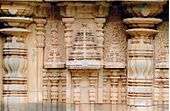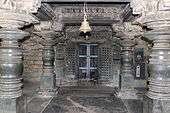Siddhesvara Temple

_in_Siddhesvara_temple_at_Haveri.jpg)
The Siddhesvara Temple (also spelt Siddheshvara or Siddheshwara) is located in the town of Haveri in Haveri district, Karnataka state, India. It is considered an ornate example of 12th century Western Chalukyan art and is well known for the many loose sculptures of Hindu deities that exist in it.[1] However, inscriptional evidence would suggest that the initial consecration of the temple was in late 11th century.[2] An interesting aspect about the temple is that it faces west, instead of facing the rising sun in the east–a standard in Chalukyan constructions.[3] Though it is currently used as a Shaiva temple dedicated to God Shiva, historians are unsure by which faith or sect the temple was originally consecrated and to which deity.[3] This uncertainty perhaps stems from the many loose sculptures of deities that exist and the degradation of primary wall images.[3]
Temple plan

The Siddhesvara temple, which is built of soapstone,[4] is located at the east end of the town. From inscriptions, Haveri was originally called Nalapuri and was one of the oldest agraharas (place of learning) in modern Karnataka.[1] An inscription dated 1067 CE in the town mentions the grant of the village to 400 Brahmins.[5] The temple bears close resemblance to a few other Chalukyan temples in the vicinity of Haveri; the Muktesvara temple at Chavudayyadanapura, the Somesvara temple at Haralhalli and the Siddharamesvara temple at Niralgi. The entire basement of this temple has sunk by a few feet, making it necessary to descend into the open mantapa (hall).[3]
The temple may have been consecrated initially as a Vaishnava temple (to the God Vishnu), later taken over by Jains who may have removed some images from the temple and eventually become a Shaiva temple after coming under the procession of the worshippers of God Shiva.[6] This conclusion is drawn because the image of the Sun God Surya exists below the little Kirtimukhas (gargoyle faces) on the eastern wall (back wall) of the temple, though, an image of Shiva, sculpted out of an independent slab of stone and mounted in front of the Shikhara (superstructure) above the mantapa roof, would suggest otherwise.[3] Overall, the temple plan bears all the hallmarks of a standard 11th century Chalukyan construction with dravida architectural articulation to which some innovative 12th century elements such as aedicules, miniature decorative towers on pilasters, were added.[7]
Sculptures


The mantapa (hall) in the temple contains sculptures of Uma Mahesvara (Shiva with his consort Uma), Vishnu and his consort Lakshmi, the Sun God Surya, Nāga-Nagini (the male and female snake goddess), Ganapati and Kartikeya, the sons of Shiva. Shiva is depicted with four arms, holding his attributes: the damaru (drum), the aksamala (chain of beads) and the trishul (trident) in three arms. His lower left arm rests on Uma, who is seated on Shiva's lap, embracing him with her right arm while gazing into his face. The sculpture of Uma is well decorated with garlands, large earrings and curly hair.[1] The Naga and Nagini, with their tails intertwined, appear on the side of the door to the vestibule (antechamber) along with an image of Parvati. A niche depicts a curious male figure with six hands, the two lower hands each hold a linga (the symbol of Shiva) and the middle left hand holds a chakra (wheel).[3]
The architrave above the vestibule entrance bears images of Brahma, Shiva and Vishnu, with Shiva in the centre. Ganapati and Kartikeya flank Brahma and Vishnu. On either side of the doorway is a perforated stone worked window, and the main shrine (garbhagriha or cella) has a plain linga (the symbol of Shiva). Some ceiling panels contain images of the saptamatrika ("seven mothers") while a square column contains images of the ashtadikpalas ("eight guardians") along with the Hindu trimurthy ("three forms") and Surya.[5] The saptamatrikas are also carved into the wall of a step well outside.[8] The saptamatrika sculptures on friezes has the female deities, generally each with a child on the lap to denote motherhood and are identified by the vahana (vehicle) of their male counterpart, found under them. At one end of the frieze is Shiva and at the other is Ganapati. Next to Shiva are the Matrika ("mother") goddessses: Brahmi (or Brahmani), Brahma's consort, with a goose; Maheshvari, the consort of Shiva has a Nandi (bull); Vaishnavi, the consort of Vishnu has a Garuda (eagle); Kaumari, the consort of Kartikeya has a peacock; Varahi, the consort of Varaha, has a buffalo (instead of a boar); Indrani, the consort of Indra, has an elephant; and the last "mother" could be a skeletal image of Chamunda with a dog or could be a dead body.[8] Other loose sculptures in niches worthy of mention are those of Surya canopied by a seven hooded snake, and the Mahishasuramardini (a form of Durga). Within the temple premises are several old-Kannada inscriptions recording grants, the earliest of which is inscribed on a beam inside the temple and is dated to 1087 CE while another stone inscription (shilashasana) dated to 1108 CE stands outside.[5]
Gallery
- Outerwall decorative relief in the Siddhesvara temple at Haveri
 Lateral view of the Siddhesvara temple at Haveri
Lateral view of the Siddhesvara temple at Haveri Kirthimukha sculpture in Siddhesvara Temple at Haveri
Kirthimukha sculpture in Siddhesvara Temple at Haveri- Kirtimukha relief on outerwall of Siddhesvara temple at Haveri
- Old Kannada inscription (13th century) of the Seuna Yadava kingdom on pillar base in the Siddhesvara temple at Haveri
- Old Kannada inscription (13th century) of the Seuna Yadava kingdom on pillar base in the Siddhesvara temple at Haveri
- Old Kannada inscription (13th century) of the Seuna Yadava kingdom on pillar base in the Siddhesvara temple at Haveri
Notes
- 1 2 3 Rao, Nagaraja M.S. "Sculptures from the Later Calukyan Temple at Haveri". Artibus Asiae, Vol. 31, No. 2/3 (1969), pp. 167–178. Jstor-Artibus Asiae Publishers. Retrieved 2007-11-10.
- ↑ Foekema (2003), p. 56
- 1 2 3 4 5 6 Cousens (1926), p. 85
- ↑ Foekema (2003), p. 55
- 1 2 3 Cousens (1926), p. 86
- ↑ Cousens (1926), p. 85
- ↑ Foekema (2003), p. 56–57
- 1 2 Cousens (1926), p. 87
References
| Wikimedia Commons has media related to Siddhesvara Temple. |
- Cousens, Henry (1996) [1926]. The Chalukyan Architecture of Kanarese Districts. New Delhi: Archaeological Survey of India. OCLC 37526233.
- Foekema, Gerard (2003) [2003]. Architecture decorated with architecture: Later medieval temples of Karnataka, 1000–1300 AD. New Delhi: Munshiram Manoharlal Publishers Pvt. Ltd. ISBN 81-215-1089-9.
- Rao, Nagaraja. "Sculptures from the Later Calukyan Temple at Haveri". JSTOR. Artibus Asiae. Retrieved 2007-12-13.
Coordinates: 14°47′26″N 75°24′39″E / 14.79056°N 75.41083°E